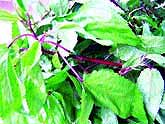In their search for food to satisfy hunger, ancient people gradually discovered the healing properties of various plants. For example, jute leaves are not only delicious but also help treat constipation, cough, and insufficient milk supply…
According to herbalist Trần Khiết (Ho Chi Minh City), the following vegetables and fruits are not only nutritious but also medicinal:
Jute Leaves
 |
| Jute plant (Photo: amthuc) |
Nutritious: Cook with pig trotters or minced lean meat to make soup.
To treat retained placenta: Take a handful of jute leaves, wash them clean, pound them finely, and mix with a little water (cooled boiled water), then strain to get about 100 ml. Divide into 2 doses to drink (each dose 10 minutes apart); after about 15-30 minutes, the placenta will be expelled, and the mother will no longer feel abdominal pain. Some people use pounded jute leaves applied to the soles of the feet to help with retained placenta.
To treat thrush: Use about 10 grams of jute leaves, wash them clean, pound them finely, add a little water, strain, and use cotton or thin fabric to apply this liquid to the tongue, gums, and mouth of the child.
To treat fishbone obstruction: Use fresh jute leaves and stems, pound them finely, and extract the juice to gargle slowly (note: only for small fishbone obstructions).
Malabar Spinach
To cool the body, promote urination, and relieve constipation: Use Malabar spinach to cook soup or boil it to eat.
For children with constipation, women in labor, and those with red, hot eyes: Use Malabar spinach leaves to extract juice to drink or apply to the eyes (this method is commonly used by people in Indonesia).
To treat swollen, red, hot breasts: Pound Malabar spinach leaves to extract juice for drinking, while using the residue to apply to the breasts.
To treat prickly heat: Use dried Malabar spinach seeds, grind to a fine powder, and apply to the affected areas of the skin.
Perilla Leaves
To relieve colds: Use 50 grams of white rice to cook a thin porridge. When the porridge is cooked, add salt, pepper, and a small amount of chopped green onions, and stir in 10 fresh perilla leaves to eat while still hot.
Jute
 |
| Jute (Photo: TN) |
To treat constipation, cough, and fatigue: Use young jute leaves to cook soup for consumption.
To treat insufficient milk supply: Eat jute regularly, from 150 to 250 grams.
To treat constipation and dysentery: Jute has mucilaginous properties that help relieve constipation; consuming jute soup for about a week will help.
Additionally, jute seeds are used as a diuretic, to facilitate bowel movements, and to reduce water retention in edema.
Vietnamese Coriander
To treat food poisoning and allergies to cold, fishy foods: Use fresh coriander from 40 to 80 grams, wash it clean, and eat it raw.
To treat snake bites: Use both the stem and leaves of fresh coriander (from 40 to 80 grams), decoct to drink or chew, and apply the residue to the bite area.
To treat skin rashes and itchiness: Take fresh coriander leaves and tops, pound them, and apply to the itchy areas for relief.
Cilantro
Cilantro comes in two types: green-stemmed and purple-stemmed. Commonly, people use cilantro as a spice to stimulate digestion.
Cilantro seeds are often used to treat bloating, stomach discomfort, and indigestion by using 20-30 seeds, crushing them, and steeping in boiling water for about 15 minutes (to release essential oils); fresh ginger can be added for enhanced effect.
Lemon Basil
Lemon basil is used to treat coughs caused by colds, especially during the cold season, by using 7-10 leaves, washing them clean, dipping in salt, and chewing raw or pounding to extract juice for drinking. Additionally, lemon basil can be combined with lemongrass, eucalyptus leaves, guava leaves, sweet basil, and ginger leaves to brew water for steam inhalation to relieve colds and coughs effectively.
















































